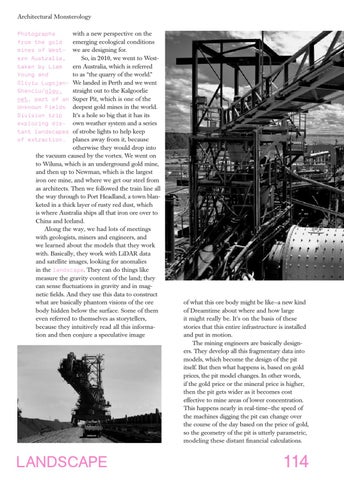Architectural Monsterology with a new perspective on the emerging ecological conditions we are designing for. So, in 2010, we went to Western Australia, which is referred to as “the quarry of the world.” We landed in Perth and we went straight out to the Kalgoorlie Super Pit, which is one of the deepest gold mines in the world. It’s a hole so big that it has its own weather system and a series of strobe lights to help keep planes away from it, because otherwise they would drop into the vacuum caused by the vortex. We went on to Wiluna, which is an underground gold mine, and then up to Newman, which is the largest iron ore mine, and where we get our steel from as architects. Then we followed the train line all the way through to Port Headland, a town blanketed in a thick layer of rusty red dust, which is where Australia ships all that iron ore over to China and Iceland. Along the way, we had lots of meetings with geologists, miners and engineers, and we learned about the models that they work with. Basically, they work with LiDAR data and satellite images, looking for anomalies in the landscape. They can do things like measure the gravity content of the land; they can sense fluctuations in gravity and in magnetic fields. And they use this data to construct what are basically phantom visions of the ore body hidden below the surface. Some of them even referred to themselves as storytellers, because they intuitively read all this information and then conjure a speculative image
Photographs from the gold mines of Western Australia, taken by Liam Young and Oliviu LugojanGhenciu/olgv. net, part of an Unknown Fields Division trip exploring distant landscapes of extraction.
LANDSCAPE
of what this ore body might be like—a new kind of Dreamtime about where and how large it might really be. It’s on the basis of these stories that this entire infrastructure is installed and put in motion. The mining engineers are basically designers. They develop all this fragmentary data into models, which become the design of the pit itself. But then what happens is, based on gold prices, the pit model changes. In other words, if the gold price or the mineral price is higher, then the pit gets wider as it becomes cost effective to mine areas of lower concentration. This happens nearly in real-time—the speed of the machines digging the pit can change over the course of the day based on the price of gold, so the geometry of the pit is utterly parametric, modeling these distant financial calculations.
114
